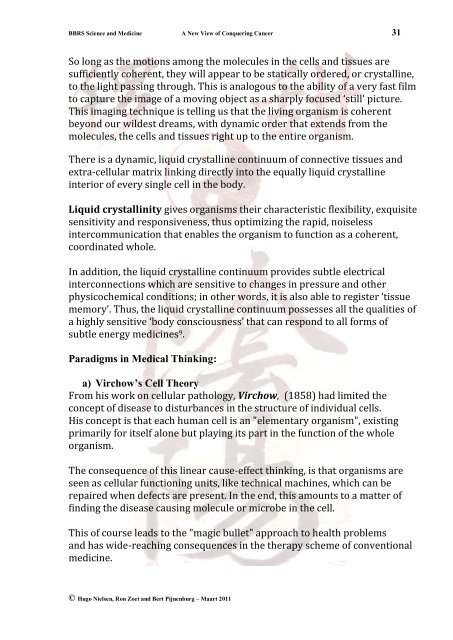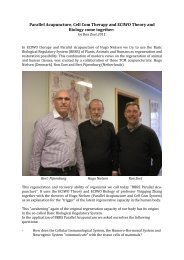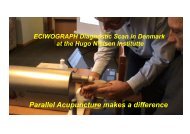BBRS SCIENCE AND MEDICINE RON ZOET Biocommunication ...
BBRS SCIENCE AND MEDICINE RON ZOET Biocommunication ...
BBRS SCIENCE AND MEDICINE RON ZOET Biocommunication ...
You also want an ePaper? Increase the reach of your titles
YUMPU automatically turns print PDFs into web optimized ePapers that Google loves.
<strong>BBRS</strong> Science and Medicine A New View of Conquering Cancer 31<br />
So long as the motions among the molecules in the cells and tissues are<br />
sufficiently coherent, they will appear to be statically ordered, or crystalline,<br />
to the light passing through. This is analogous to the ability of a very fast film<br />
to capture the image of a moving object as a sharply focused ‘still’ picture.<br />
This imaging technique is telling us that the living organism is coherent<br />
beyond our wildest dreams, with dynamic order that extends from the<br />
molecules, the cells and tissues right up to the entire organism.<br />
There is a dynamic, liquid crystalline continuum of connective tissues and<br />
extra-cellular matrix linking directly into the equally liquid crystalline<br />
interior of every single cell in the body.<br />
Liquid crystallinity gives organisms their characteristic flexibility, exquisite<br />
sensitivity and responsiveness, thus optimizing the rapid, noiseless<br />
intercommunication that enables the organism to function as a coherent,<br />
coordinated whole.<br />
In addition, the liquid crystalline continuum provides subtle electrical<br />
interconnections which are sensitive to changes in pressure and other<br />
physicochemical conditions; in other words, it is also able to register ‘tissue<br />
memory’. Thus, the liquid crystalline continuum possesses all the qualities of<br />
a highly sensitive ‘body consciousness’ that can respond to all forms of<br />
subtle energy medicines 9 .<br />
Paradigms in Medical Thinking:<br />
a) Virchow’s Cell Theory<br />
From his work on cellular pathology, Virchow, (1858) had limited the<br />
concept of disease to disturbances in the structure of individual cells.<br />
His concept is that each human cell is an "elementary organism", existing<br />
primarily for itself alone but playing its part in the function of the whole<br />
organism.<br />
The consequence of this linear cause-effect thinking, is that organisms are<br />
seen as cellular functioning units, like technical machines, which can be<br />
repaired when defects are present. In the end, this amounts to a matter of<br />
finding the disease causing molecule or microbe in the cell.<br />
This of course leads to the "magic bullet" approach to health problems<br />
and has wide-reaching consequences in the therapy scheme of conventional<br />
medicine.<br />
© Hugo Nielsen, Ron Zoet and Bert Pijnenburg – Maart 2011





